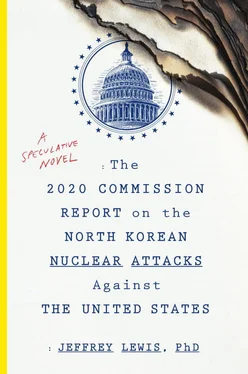Jeffrey Lewis - The 2020 Commission Report on the North Korean Nuclear Attacks Against the United States
Здесь есть возможность читать онлайн «Jeffrey Lewis - The 2020 Commission Report on the North Korean Nuclear Attacks Against the United States» весь текст электронной книги совершенно бесплатно (целиком полную версию без сокращений). В некоторых случаях можно слушать аудио, скачать через торрент в формате fb2 и присутствует краткое содержание. Город: New York, Год выпуска: 2018, ISBN: 2018, Издательство: Mariner Books, Жанр: Фантастика и фэнтези, Триллер, на английском языке. Описание произведения, (предисловие) а так же отзывы посетителей доступны на портале библиотеки ЛибКат.
- Название:The 2020 Commission Report on the North Korean Nuclear Attacks Against the United States
- Автор:
- Издательство:Mariner Books
- Жанр:
- Год:2018
- Город:New York
- ISBN:9-781-328-57391-9
- Рейтинг книги:4 / 5. Голосов: 1
-
Избранное:Добавить в избранное
- Отзывы:
-
Ваша оценка:
- 80
- 1
- 2
- 3
- 4
- 5
The 2020 Commission Report on the North Korean Nuclear Attacks Against the United States: краткое содержание, описание и аннотация
Предлагаем к чтению аннотацию, описание, краткое содержание или предисловие (зависит от того, что написал сам автор книги «The 2020 Commission Report on the North Korean Nuclear Attacks Against the United States»). Если вы не нашли необходимую информацию о книге — напишите в комментариях, мы постараемся отыскать её.
The 2020 Commission Report on the North Korean Nuclear Attacks Against the United States — читать онлайн бесплатно полную книгу (весь текст) целиком
Ниже представлен текст книги, разбитый по страницам. Система сохранения места последней прочитанной страницы, позволяет с удобством читать онлайн бесплатно книгу «The 2020 Commission Report on the North Korean Nuclear Attacks Against the United States», без необходимости каждый раз заново искать на чём Вы остановились. Поставьте закладку, и сможете в любой момент перейти на страницу, на которой закончили чтение.
Интервал:
Закладка:
The technical malfunction that afflicted Flight 411 was a well-known bug found in the Airbus A320 model that Air Busan used for this route that day. In the years prior to 2020, the Federal Aviation Administration (FAA) in the United States and aviation regulators in Europe had observed that A320 sometimes suffered a loss of power in the cockpit. Indeed, the failure on board BX 411 looked very much like a series of previous incidents (none of which, it must be noted, resulted in any fatalities). For instance, on October 22, 2005, a British Airways A319 flight from London Heathrow Airport to Budapest, Hungary, suffered a similar problem: as the airplane climbed through 20,000 feet, five out of its six flight displays went blank and the autopilot disconnected. The VHF radio and intercom stopped working, and most of the lights went out in the cockpit. In January 2008, a United Airlines flight from Newark to Denver suffered a nearly identical failure.
Following the 2008 incident, the FAA issued a 2010 order that gave US airlines four years to deal with this issue by modifying any Airbus aircraft in their fleets. The FAA’s European counterpart issued a similar regulation in 2009. South Korean regulators did not. Even if stronger regulations had been in place, however, they probably would not have saved BX 411. At least four such incidents had occurred in the United States after the FAA directive was issued in 2010.
Airbus strongly denied responsibility for the outcome of this particular incident. The company’s director of flight operations explained that electrical failures are common in all makes of jet aircraft, and he noted that the Airbus 320 has backup systems in place to effectively address power loss in the cockpit. Airbus officials also noted that, although this problem has occurred frequently in the A320 model, there had not been a single fatality prior to the events of March 2020. “The loss of the BX 411 was the result of the actions of North Korean air defenses,” a company spokesperson told investigators, “not the temporary power loss in the aircraft cockpit which for most systems lasted less than two minutes.”
The company’s statement is technically accurate. Judging by the timing of the next radio transmission from Flight 411 to South Korean air traffic control, the pilot and copilot of Air Busan Flight 411 were able to restore power to most affected systems in about two minutes. But a few other systems took longer. As in other such incidents, it took about six minutes for the pilot and copilot to bring all systems back on line, after which the aircraft was operating normally.
During this period, the aircraft was flying at 400 miles per hour. Over the course of those six minutes, it traveled more than 50 miles. As crucial minutes ticked away, the aircraft missed its turn west and continued on a northwest route, heading north past Seoul and toward the DMZ separating North and South Korea. When the pilot realized that the aircraft was rapidly approaching North Korean airspace, she radioed air traffic control and was told to turn the aircraft westward and follow a path out to the Yellow Sea. As in other cases of temporary electrical failures, the captain made the decision to continue toward her destination, expecting that her westward turn would bring her back onto the original flight path to Ulan Bator.
The captain, Chung Jae Eun, has been criticized for continuing the flight, but her decision was not unusual. Other commercial pilots had made similar decisions with no adverse outcomes, including the captain of the stricken Airbus A320 flying from London to Budapest in 2005, who completed that flight as planned despite the problems with the aircraft’s flight displays, radio, cockpit lights, and other affected systems. While air traffic control had ordered Flight 411 to turn west to avoid North Korean airspace, controllers did not require Captain Chung to further alter her flight plan. Had another factor not intervened, the 228 passengers aboard BX 411 probably would have landed safely in Ulan Bator a few hours later.
But there was another factor—one that until now has remained largely classified. It was publicly known that the United States and South Korea were holding the annual FOAL EAGLE/KEY RESOLVE military exercise. North Korea routinely objected to such exercises because the massing of an enormous number of forces in South Korea for the exercises was indistinguishable, from a North Korean point of view, from preparations for an invasion. The North Korean military was therefore on edge and alert to any provocation.
But unbeknownst to most political and military leaders, not to mention South Korea’s civil aviation industry, in the months preceding the events of March 2020 the United States had initiated a covert program of air and naval probes as part of an extensive psychological operations campaign against the regime of North Korean dictator Kim Jong Un. In the final year of this commission’s investigations, press reports have described a broad program of psychological operations (PSYOP) initiated by the Trump administration late in 2019, after the collapse of the diplomatic thaw that had begun with North Korea’s participation in the Pyeongchang 2018 Olympic Winter Games. The commission has been asked specifically to investigate the role these operations may have played as a contributing factor in North Korea’s shootdown of BX 411 and, more generally, the nuclear exchange that followed.
The commission was given access to a number of classified documents concerning these covert US programs, and we have also had the opportunity to conduct extensive interviews with former officials who served in the Trump administration. In doing so, our primary goal has been to understand the role these operations may have had in shaping the subsequent decisions made by Kim Jong Un. While many aspects of these programs remain classified, they have been broadly described in the press, and some key details have been declassified to allow the public to understand how these operations may have contributed to the shootdown of Air Busan Flight 411 and the chain of events that followed.
This campaign comprised various air and naval efforts, the most consequential of which appears to have been an operation undertaken by the US Air Force. Known internally within the US government as SCATHE JIGSAW, this operation used bomber flights to systematically probe North Korean air defenses. According to documents provided to the commission and interviews with participants, the United States conducted twelve bomber missions under SCATHE JIGSAW to collect data on North Korean air defense capabilities and convey US resolve to Kim Jong Un. These missions are summarized in Table 1.
TABLE 1. SCATHE JIGSAW BOMBER FLIGHTS
| NUMBER | DATE | NUMBER OF AIRCRAFT | TYPE OF AIRCRAFT | ORIGIN |
|---|---|---|---|---|
| 1 | December 7, 2019 | 3 | B-1B | Andersen AFB (Guam) |
| 2 | December 18, 2019 | 6 | B-1B, B-2, B-52 | Andersen AFB (Guam), Whiteman AFB (CONUS), Kadena AFB (Okinawa) |
| 3 | December 25, 2019 | 3 | B-1B | Andersen AFB |
| 4 | January 8, 2020 | 1 | B-2 | Whiteman AFB |
| 5 | January 10, 2020 | 4 | B-1B, B-2 | Andersen AFB |
| 6 | January 24, 2020 | 2 | B-1B | Andersen AFB |
| 7 | January 26, 2020 | 2 | B-2 | Whiteman AFB |
| 8 | February 8, 2020 | 3 | B-2 | Whiteman AFB |
| 9 | February 18, 2020 | 4 | B-1B | Andersen AFB |
| 10 | February 29, 2020 | 2 | B-2 | Whiteman AFB |
| 11 | March 6, 2020 | 1 | B-1B | Andersen AFB |
| 12 | March 12, 2020 | 3 | B-1B | Andersen AFB |
Pentagon officials developed SCATHE JIGSAW on the basis of a Reagan-era program of psychological operations initiated to strengthen deterrence against Moscow. “It really got to the Soviets,” is how one official explained the earlier program. “They had no idea what it all meant. Bombers would fly straight at Soviet airspace, forcing them to turn on their radars and put aircraft on alert. At the last minute, the bombers would peel off and fly home.”
Читать дальшеИнтервал:
Закладка:
Похожие книги на «The 2020 Commission Report on the North Korean Nuclear Attacks Against the United States»
Представляем Вашему вниманию похожие книги на «The 2020 Commission Report on the North Korean Nuclear Attacks Against the United States» списком для выбора. Мы отобрали схожую по названию и смыслу литературу в надежде предоставить читателям больше вариантов отыскать новые, интересные, ещё непрочитанные произведения.
Обсуждение, отзывы о книге «The 2020 Commission Report on the North Korean Nuclear Attacks Against the United States» и просто собственные мнения читателей. Оставьте ваши комментарии, напишите, что Вы думаете о произведении, его смысле или главных героях. Укажите что конкретно понравилось, а что нет, и почему Вы так считаете.












